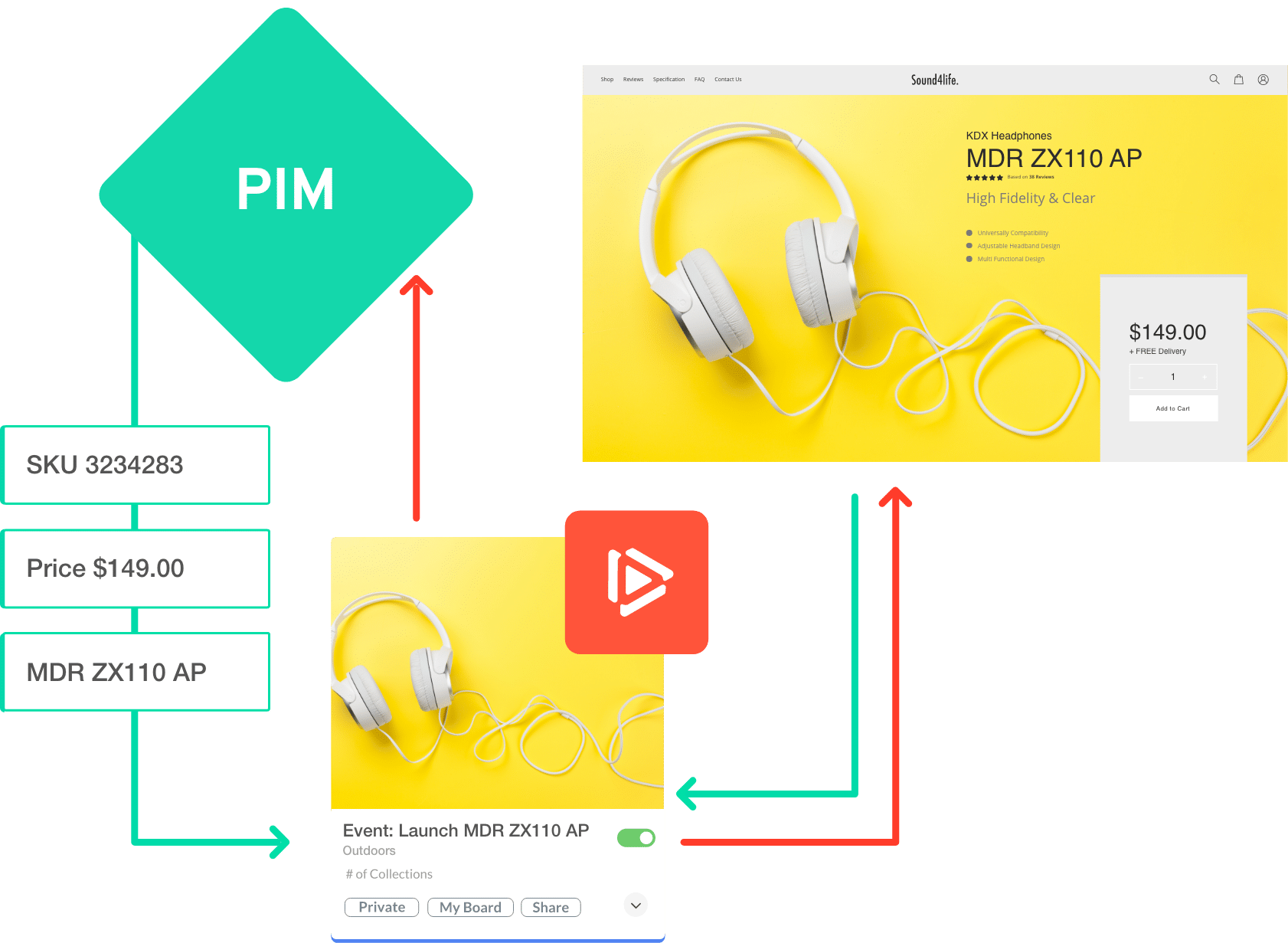Your DAM wants to work harder for you. Explore some lesser-known features of your digital asset management system to produce better creative work with less effort.
Look down at your keyboard right now. Chances are, your F and J keys have little raised bumps on them. They are there to make it easier for your hands to find their place without looking down at your keyboard. Many of us overlook this helpful little feature on the devices we use every day.
DAMs are like this too—while we all know that you can use them to upload, store, and search for assets, DAMs also offer many lesser-known features that allow creative teams to produce better work more efficiently. In this article, we’ll share five underutilized DAM features that you may be missing out on. Master these and you can achieve more with your DAM than you realized possible—everything from building a more equitable creative team to increasing the bottom line of your business.

1 - Tag Assets Automatically Using AI
Tagging assets is an essential part of creating a searchable DAM, but let’s face it—It can be extremely tedious. Luckily, today, many DAMs allow you to automatically tag assets using AI image recognition.
You can simply upload assets to your DAM and you’ll be shown a list of AI-generated tags. Then pick which ones you want to apply as metadata.
The software can understand a photo or video in several ways. It can:
- Recognize the brand of a product and tag an image accordingly
- Recognize individuals’ faces and tag them
- Tag based on topic or complex concepts—like “glamorous theater”
- Identify and separate individual scenes within a video
- Conduct real-time speech-to-text translation in 30+ languages
All that metadata is stored in the DAM, so you can later search for photos with a particular model or mood. AI tagging makes a huge difference in the overall success of your DAM because many users are too busy to take the time to tag thoroughly and comprehensively. What’s more, creatives often tag things based on how they produced the creative—the campaign, the date, the team involved—but this often differs from what others in the organization may search to find it.
For example, someone may upload a campaign using tags like “fall 2023 campaign” or the name of the photographer. But others in the organization may be likelier to search based on keywords like the product name or the mood of the image. When machine learning does the tagging—or augments individuals’ tags—content becomes a lot more discoverable. (That being said, make sure to carefully check any AI tags before applying them to avoid introducing bias.)
2 - Automatically Remove Access to Expired Assets
If your organization does a lot of licensing—either selling licenses to your assets or buying licenses to others—managing the fine print of these contracts and when they expire can be a real pain. That’s why many opt to use a digital rights management platform or a DRM, to automate much of this hassle. However, when this content crosses over into your DAM, it adds an extra layer of complexity.
However, if you integrate your DAM with your DRM, or if your DAM has a built-in DRM, you can mitigate a lot of the manual work to keep everything organized and up to date. Specifically, integrating these systems lets you automatically leverage the agreements in your DRM to control access to content within your DAM. Your DAM can ingest licensing info and remove assets from view when your license to use them expires. This prevents you from making costly errors or running into legal troubles. And if you’re the one licensing assets to others, you can also pull access to those assets automatically when the agreement expires. In a more advanced maneuver, you can also automatically attach agreement details like approved use cases and regions so that your DAM will only grant access to content to assets under the conditions you’ve specified.
3 - Make Progress on Your DEI Goals
As creatives operating in a deeply flawed world, we all have a crucial role to play in making our content more inclusive. What many people don’t realize is that your DAM can be an invaluable tool for your equity-minded organization. For example, if you tag photography about the people’s race, gender, ability, culture, and language in assets—provided the models consent to this and opt to self-identify—you can later search these terms to easily surface inclusive photography when you need it.
You can also sensitively address any mistakes of the past using content warnings in your DAM. While some companies opt to remove harmful content from their DAM entirely, many others opt to keep these assets in their DAM as a means of accountability and an opportunity to teach moving forward. With this approach, you can allow content to be viewed in the DAM but only under certain conditions (e.g. only viewable, never downloadable) and with proper context (i.e. a statement on why it’s harmful and how your company has thoughtfully mitigated that harm).

As creatives operating in a deeply flawed world, we all have a crucial role to play in making our content more inclusive. What many people don’t realize is that your DAM can be an invaluable tool for your equity-minded organization. For example, if you tag photography about the people’s race, gender, ability, culture, and language in assets—provided the models consent to this and opt to self-identify—you can later search these terms to easily surface inclusive photography when you need it.
You can also sensitively address any mistakes of the past using content warnings in your DAM. While some companies opt to remove harmful content from their DAM entirely, many others opt to keep these assets in their DAM as a means of accountability and an opportunity to teach moving forward. With this approach, you can allow content to be viewed in the DAM but only under certain conditions (e.g. only viewable, never downloadable) and with proper context (i.e. a statement on why it’s harmful and how your company has thoughtfully mitigated that harm).
For a deeper dive into DEI in DAM, check our in-depth guide:
4 - Make Your DAM More Searchable by Automatically Attaching Product Information
A DAM is as useful as it is searchable. And if your company sells hundreds or thousands of products with many variations, things can get hairy real fast. If you want a colleague on the other side of the world to be able to search “size 7 neon green sneakers with rainbow laces” and get instant results, you need to make sure the tags are there to support it. That’s where an integration with your product information management system (PIM) can be a lifesaver. PIMs typically host product descriptions, specifications, unique ID numbers like SKUs, and/or a variety of other product attributes.
A bi-directional integration between your DAM and your PIM has innumerable benefits (read more about them here), but one of the most time-saving benefits is allowing the DAM to automatically pull in product data and attach it to assets. This integration greatly improves searchability. Now users can search for just an SKU number in the DAM and pull up all assets related to that product. Then you can use either more product information like specifications or dimensions, or use the DAM’s metadata tags and keywords, like colors or subjects, to filter and find the right content.

5 - Monitor Which Assets Increase the Bottom Line

We saved the best for last. While every department in a company is tasked with different goals, ultimately everyone is indirectly (or directly) responsible for driving revenue. Using an integration with your business intelligence or BI tool, your DAM can now ingest the performance data from all your advertising and marketing suites to associate individual pieces of creative or entire campaigns to metrics like views, clicks, or purchases.
This allows the DAM to produce machine-learning recommendations. Even a tiny nudge can help creative teams and executives with creative budget get more for their spend, and machines can see things that might be imperceptible to people. For example, noticing that one model of BBQ grill slightly outperforms others in photos, or that the third image in an ad carousel ought to be the first.
You can also use your DAM’s built-in reporting to see which images are being used the most often (or not being used at all). This can give you valuable insight into which content types are worth the investment, and which content you’d be wise to pull back from creating more of.
Go Beyond What You Thought Your DAM Could Do for You
If you know how to use it properly, your DAM can be like a Swiss Army knife of functionality. As part of the MACH Alliance, we believe that forward-thinking organizations are better off buying the best-in-class tool for every function in their business than tools that try to do everything.
And if you don’t yet have a DAM in place, or are unsatisfied with your current product, make sure to ask if these features are available when you speak with vendors.
